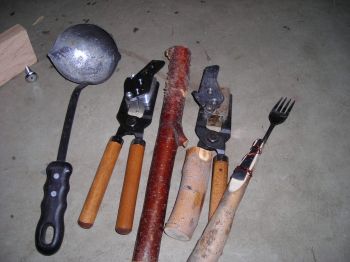
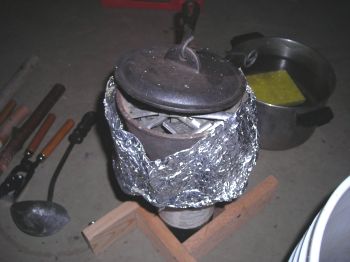
*Casting Lead Bullets*
There are several reasons to cast your own bullets. Accuracy could be one. Authenticity could be important if you are into cowboy shooting. I do it because it is a super-cheap way to make practice ammo. This is how to cast bullets on the cheap.
First, get your tools:


Get some lead. I use old wheel weights from the tire shop. Whenever I go in for a repair, rotation or snow tires, I bring a bucket. They do sell the scrap lead to a recycler, but are more than willing to give it to a loyal customer. The weights are very dirty and full of grime and junk. That's ok; it all comes out in the melting.
It's important to remember never to add lead to a pot of molten metal if there is any chance that the lead is wet. Adding water (boiling at 212) to a pot of lead (??? 600 degrees???) you will get an explosion of steam. The will shoot hot lead all over the place. Yet another reason to wear long sleeves and gloves to do this task.
Keep an eye on the pot. When it's all melted, skim the junk off with a long-handled fork into a tin can. Dribble some candle wax into the pot and stir it around to flux. Don't worry if it bursts into flame. Skim some more.
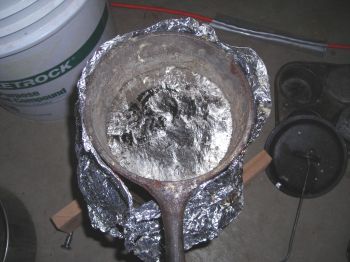
When your mold is hot, you are ready to cast. I heat the Lee molds I use by dunking them in the pot of metal. It sticks at first, but soon the mold reaches the proper temperature. You can judge if it's right by ladling some lead into the mold. If it freezes up before filling the mold, it's too cold. If the lead dribbles out of the mold and takes more than a few seconds to freeze, the mold is too hot; give it a minute to cool. If your mold is just a little too hot, you will produce "winged" bullets, which go back into the casting pot as unusable.
Once your lead is molten and clean, and your mold and ladle are up to temperature, it's time to flux again and try a few bullets. Hold the mold with your left hand, and the rapping stick with the little fingers of your left hand, hanging down. Dip the ladle with your right hand, you don't need much lead. Pour it into the top of the mold, so that the lead fills both sprue holes and forms a puddle on top of the mold. Don't worry about over-filling, it will just run off the mold back into the pot. (you ARE holding the mold over the pot, right?)
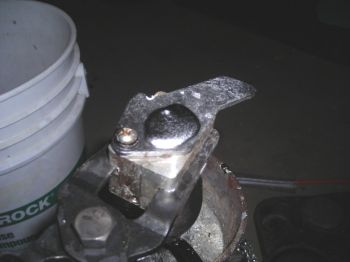
Use the rapping stick to knock open the sprue plate (dropping the puddle of frozen lead and the sprue back into the pot) and open the mold over the pot of water. If the bullets are good, knock them out by tapping the mold with the stick. Drop the bullets onto the sponge to cool. If the bullets are no good (and your first few won't be) tap them out over the pot of lead. NEVER put anything wet into the lead pot! If you drop deformed bullets into the water, they stay there! You can reuse them next time you heat up a batch of solid lead, NOT this time.
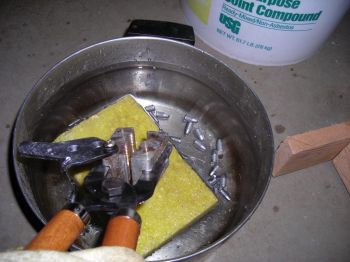
Keep up the casting process until you run out of lead, or have enough bullets. The mold temperature will fluctuate a little as you go. If your bullets start looking "frosty" the mold is too hot, and if they are deformed the mold is too cool. With Lee aluminum-body molds like these, the hot lead in the mold itself usually keeps the mold to the correct temperature without any worry.
Flux with candle wax and skim the dross every 15 minutes or so.
When you are finished casting, you need to cast the extra lead into ingots for later use. I use an old muffin tin to cast lead muffins. Use the hot ladle to melt some wax into each cup of the muffin tin: this helps the lead muffin pop out of the mold, just like greasing the pan in cooking. Pour your lead into the cups; don't over fill, or you may not get the muffin out.
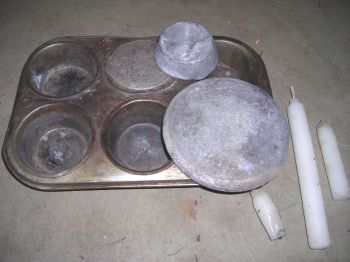
Now that you are done casting, and the muffins are cooling in a safe place, and the rest of the gear is cleaned up and put away, it is time to finish the bullets. Fish them out of the pot of water and sort them into usable and unusable piles. I'm pretty generous in my sorting, if the bullet has a good base and no wings on the front, I'm likely to use it. Any real losers are tossed back into the pot for remelting next time. Spread the bullets out on a towel to dry. When they are dry put a double handful into a lidded plastic bowel (I use an old butter tub) and squirt about a spoonful of Lee Liquid Alox on them. Seal the bowel and gently roll it around for a minute. This coats the bullets evenly with lube. Pour the bullets out onto a piece of waxed paper to dry. Leave them overnight. You can repeat the lubing process for a second coat if you want, but I find it unnecessary. When the lube dries, you can load and shoot the bullets just like regular lead bullets, but without any pesky resizing or gooey lube.
Note: Lee makes tumble lube bullets in a variety of weights and calibers, but I've only used the .357's. They have worked very well for me, and I've had no problems with excessive leading or inaccuracy.
Cost: If you are considering casting because of cost savings, here's the breakdown.
Total: 3.5 cents per shot, just a little more than .22LR. If you don't value your time, or consider casting and reloading to be hobbies, then casting is cheap. On the other hand, if you want to figure costs for your time, it's expensive. On the gripping hand, casting and reloading are self-sufficiency skills, and we should know how to do them just because.
Don't burn yourself!
SlimJim
www.alpharubicon.com
All materials at this site not otherwise credited are Copyright © 1996 - 2007 Trip Williams. All rights reserved. May be reproduced for personal use only. Use of any material contained herein is subject to stated terms or written permission.